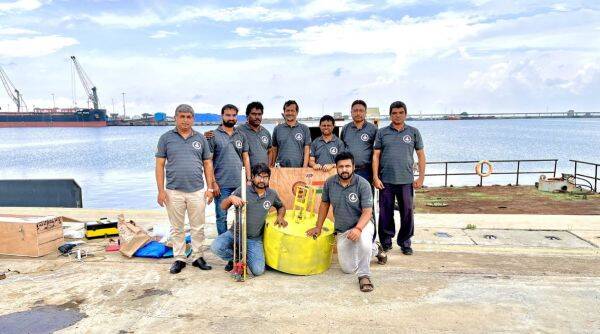Researchers at IIT Madras have developed and tested a system for generating electricity from seawaves. The Sindhuja-I system was deployed by the researchers about six kilometers off the coast of Tuticorin in Tamil Nadu, where the sea is about 20 meters deep. Sindhuja-I can currently generate 100 watts of power. In the next three years, it will be scaled up to produce one megawatt of energy.
“Currently, if you want to power a city like Chennai or a small part of it, it would be very expensive to do it with wave power and it would be much cheaper to use conventional energy sources. But for remote applications like on island and offshore locations, the cost of transporting power over the sea could be higher than generating electricity from waves at the location,” Abdus Samad, who led the research, told indianexpress.com. Samad is a professor at the Department of Ocean Engineering at IIT Madras.
Sindhuja-I is made up of a floating buoy, a spar, and an electrical module. As the waves oscillate up and down, the buoy moves up and down. This buoy has a hole in the center that will allow the spar to pass through. The spar is secured to the seafloor to prevent it from being moved by the waves. When the buoy moves but the spar does not, the waves cause a relative motion between the two. An electric generator uses this relative motion to generate power.
However, constructing such a complex system in an offshore location presents its own set of challenges. The amount of energy generated by wind energy, for example, varies throughout the day and throughout the year as the climate changes.
“During different seasons, wave height and period change. It is okay if the system does not produce energy when the weather is calm. But what is important is to make sure that the system can endure rough weather because there is no point investing so much in a system if it gets washed away during difficult weather,” explained Samad.
This is also why the researchers tested the system in November when IMD (India Meteorological Department) issued a red alert for districts in the state of Tamil Nadu. “We were very happy to find out that our systems worked very well and did not get badly affected by difficult conditions,” he said.
As the system is still in its infancy, no devices are currently using the power generated by it. The research team intends to install a remote water desalination system as well as a surveillance camera at the site by December 2023. It also intends to conduct additional testing to better understand how to deal with fluctuations in power generation caused by weather events.
This wave energy system is being developed at a time when there is growing global interest in the potential of using waves to generate electricity. The US Department of Energy announced a $25 million grant to companies demonstrating technologies that can harness waves to generate electricity in January of this year. In addition, the European Union hopes to generate 10% of the region’s power demand through ocean energy by the year 2025.
While the wave energy generation device developed by IIT Madras researchers employs a technology known as “point absorber wave energy converter,” it is only one of many such technologies being developed by companies around the world. The Islay LIMPET, the world’s first grid-connected wave energy power device, was deployed in 2000 and uses a shoreline device that generates power using “Oscillating Water Column” technology. It was eventually decommissioned in 2018. However, Samad believes that such grid-scale technology is still a long way off for Indian shores.
Source:IE







 Finance
Finance







